Ray-Lin Dairy
environment
Is my milk safe?
Cleanliness and safety is something that we think about before we even think about milking the cows. Cleanliness starts with the cow beds andalso by keeping our cows healthy . We wash our milk pipelines three times a day once between every milking shift, the milk tank is washed once a day after it has been emptied and the milk pumped out and onto the tanker truck. Food safety is something paid close attention to on a dairy farm here are few pictures showing what we do to produce healthy refreshing milk!

This tank cools the milk and stores it at a chilly 39 degrees. This is a brand new 5000 gallon milk tank we installed a few months ago.

Inside these stainless steel tubes the milk is filtered before ending up in the milk tank. Fresh new filters are installed before each milking shift.
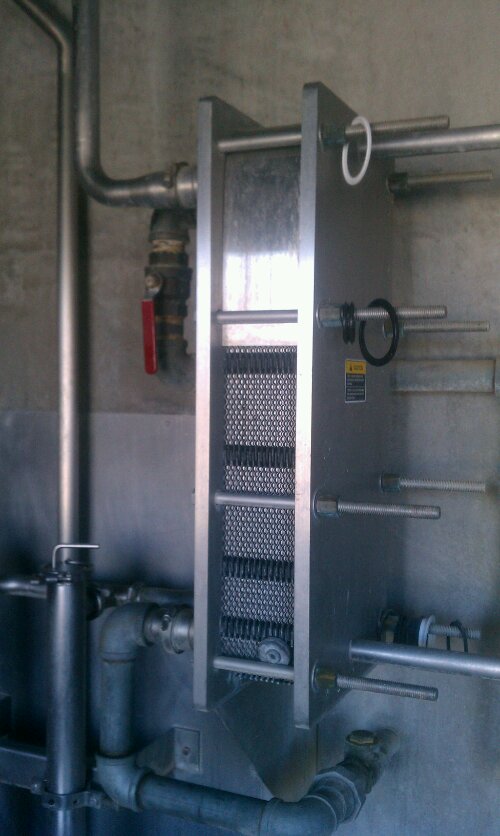
This is a plate cooler that uses water to help cool the milk by nearly 20 degrees before the milk enters the milk tank.

This chart tracks the temperature of the milk and is changed every 48 hours. If you notice the two spikes in temperature they are when the tank is washed daily after the milk is pumped into the milk truck to be taken to the milk plant.

This sink is where the cleaning agents are m ixed with water to wash the pipelines the milk flows through. It is like a big dishwasher for pipes and is used after each milking shift.

the cows teats are dipped with an 1% iodine and lanolin solution to keep them soft and clean.

Although hard to see because it is a clear gold color this is a peroxide based teat sanitizer we use before the cow is milked. It also has lanolin in it to keep the teats soft..

The cleaning agents are automatically added to the wash sink for employee safety.
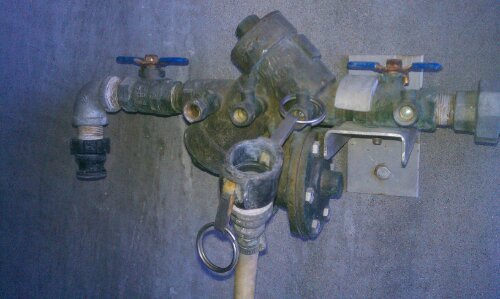
We even take safety as far as protecting our water supply from being contaminated with cleaning agents or milk.

The milking machines are washed in between every milking shift
Peek a Boo Sun

Beautiful sunrise and one reason we enjoy working with the cows because we can witness natures grandeur first hand.
Awesome sunrise taken from one of our barns.
Just a farmer… Just a person…
Today’s thought: Farmers are people too, we enjoy many of the same hobbies as other’s who walk this great earth. We farmers might be small in numbers however mighty in what we provide as nourishment to this world. Yes farmers are humans first and we are emotionally connected to being the best caretaker’s we can be for our great resources in this world.
Related articles
- Young Farmers & Ranchers-Why We’re Here (farmbureau.wordpress.com)
- Join the Conversation About the Food You Produce (farmbureau.wordpress.com)
Lazy Summer Morning
Here is a cow picture for Wordless Wednesday.
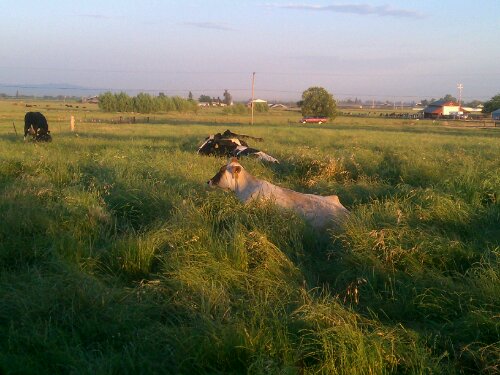
A few of our cows enjoying the cool morning before a hot summer day here in Central California.
These cows were just moved into this pasture yesterday and are relaxing in the grass. With all the late rains we had here in the Central Valley and now the heat the grass is growing very quickly in the pasture. these cows need to get up and get to work eating it down!
Posted from WordPress for Android
Related articles
- Cows play in sprinklers? Wordless Wednesday (raylindairy.wordpress.com)
Cows play in sprinklers? Wordless Wednesday
This started out as a Wordless Wednesday however I decided to add some background information.
Today I’m doing maintenance work on one of the major pieces in our cow comfort system the soakers that help keep the cows cool during the summer.
Here is a picture of the cows enjoying the cool shower just like kids playing in the sprinkler do during the summer.

Cows being cooled by the soaker system.
The soakers come turn on to soak the cows and then are off for a period of time to allow the water to evaporate and creating evaporative cooling. This type of cooling is the same cooling feeling you get right after getting out of a swimming pool on a hot day. We locate the soakers over the cows food so they are more comfortable while eating and their food intake stay’s up during hot days when they need the energy.

This little box is a great help to keep cows comfortable
This controller uses the temperature at the cow level to adjust the on and off times so the optimum cooling of the cows is maintained.
Posted from WordPress for Android
What do you do with all that cow poop?
Many times we get asked the question “What do you do with all the poop from the cows?”.
The pictures below are a visual of how we turn what many think of as waste into a nutrient for our crops in our quest to be a sustainable and friendly to the environment dairy farm.
Making the Cow Beds
Here is a look into what goes into providing the cows on our farm clean soft comfortable beds to lie in. The pictures are from start to finish and show how we take solid manure sterilize and dry it, with a process similar to composting, the finished product is essentially soil we then use for bedding. On our farm we use 95% of the solid manure from the cows as bedding as an effort to recycle all we can and leave a minimal environmental footprint.

With use the cows tend to mess up their beds, we keep trying to get them to make their beds but to no avail.
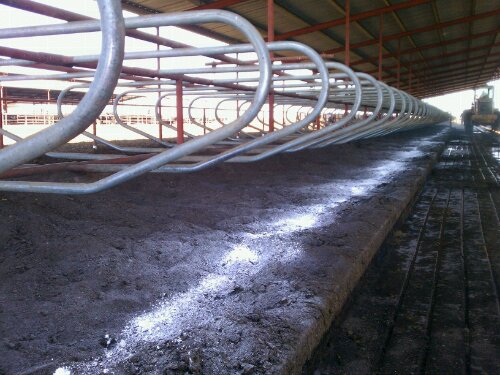
The first thing we do is put down Hydrated Lime to dry out any wet spots, yes cows do occasionally wet the bed.

Next we mix the Lime in with what we call the Freestall Groomer, we use this piece of equipment 3 times a week to re groom the beds.
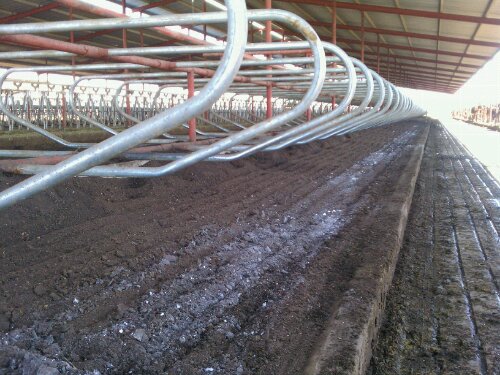
Here is what the beds look like after being groomed.

The next piece of equipment adds more bedding to the stalls.

This is the finished product a clean soft bed for the cows to lie in.

We use a process similar to composting to dry and sterilize the bedding prior to it's use.
Related articles
- Composted manure is the gardener’s best friend (sfgate.com)
- Hints, Tips and Advice on Using Manure in Your Garden (brighthub.com)
Planting the garden – Farm style!
Just remembered I had this post saved as a draft and never published it, silly me!
Here are some pictures of how we prepped the soil (using a little overkill) for our garden.
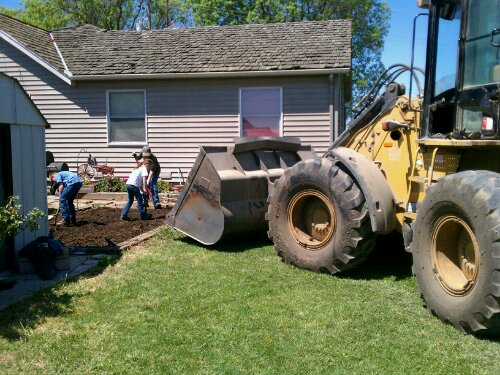
We like to go BIG on the farm!
We use our loader to get a scoop of the compost we make from the manure our cows leave behind.

Adding our own compost to the garden.
We mixed the compost into the soil to add vital nutrients that allows our vegetables to grow.
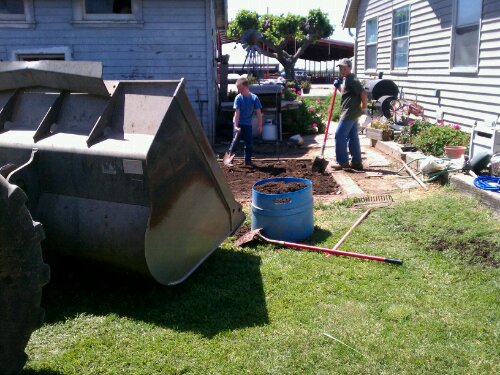

Ready to plant!
The finished product!
Related articles
- What do you do with all that cow poop? (Ray-Lin Dairy)
- Simple Compost Tea (autumnrosecottage.wordpress.com)
- The recipe for a ripe batch of manure tea (sfgate.com)
Putting the “culture” in Agriculture
I just started reading the recently released book “The Now Revolution” by Jay Baer and Amber Naslund. One of the biggest things to hit me so far is the focus on how customers can use social interactions to get the sense of the “culture” of a business and gain insight into the values a company believes in. Baer and Naslund write “Your company culture consists of two key elements: Your business’ underlying intent and the people you bring together to carry it out.” In other words personal interactions and relationships built with people and faces of the company allow customers the opportunity to learn what the company believes in and it’s core values. Another great point made in the book is : “Having a great product or business to sell is important. But if you truly have something of value to offer, the how and why you go about doing that are every bit as critical as the what.” To further define culture Baer and Naslund explain it consists of 3 parts:
○ Passion
○ Philosophy on how people who interact with the business are treated
○ Actions taken to prove your “culture”
We in agriculture need to work on building relationships with our customers (those buying and using our products) and share our values on “how and why we do what we do” with them. In farming, we may not have a formal customer service department to interact with our loyal customers and as a result they have no understanding of some of today’s innovative farm practices. On the flip side with no clear way to communicate with consumers farmers lose touch of societal shifts in eating habits and changes consumers may be wanting. We are vital pieces of the food chain, however, the only personal interactions our customers have with people in the food chain are with the employees of the supermarkets or restaurants they frequent. Does the supermarket chain and its employees have the same values as farmers? Restaurants? I would hope so however I am not willing to risk my farming future on it. As farmers we need to be cognizant that the majority of our customers learn about farming from driving by our farms as they go about their daily routines and from their interactions at farmers markets. If our customers drive by an unkempt farm what impression are they left with? If the only personal relationship with someone in agriculture is those they meet at farmer’s markets what do they think of the rest of farmers? In agriculture we as farmers care greatly for the environment, animals and our communities, however are we conveying that message through relationships? For more on creating relationships please read Building Bridges, Connecting Communities.
A good friend of mine and fellow Agvocate Chris Chinn asked the question “Who Is Telling the Story of Agriculture?” in a recent blog post. I would like to ask a different but similar question:
“What are you doing to tell the story of agriculture?”
Do you have to tell your story of agriculture online with social platforms like blogs, Twitter and Facebook? No, however you need to tell your story where you are comfortable doing so. Places such as schools, churches, civic groups and supermarkets are great opportunities to interact with others and share your values with them.
Another great way to show that we as farmers care for our communities is to sponsor roadside cleanups or community events. As a group farmers are some of the best stewards of local communities, however do those who live outside the local area see what we do? To bring more awareness to what we as farmers care about we can sponsor events in bigger communities to help others understand the “culture” of agriculture. If there are major roadways near your farm sponsor the cleanup of a section of roadway so the many cars driving by see that farmers care.
In addition to community support and social platforms other great ways to agvocate are speaking to local service and hobby groups like Larkin Martin from Alabama does. Laurie Kyle from Wisconsin uses her background working in a school library and nutrition degree to discuss inaccuracies she sees in articles by writing letters to the editor and adding comments to online articles.
Together we can put the “culture” back in Agriculture and tell the wonderful story farmers and rancher’s have to tell!
For more reading on “culture” here is a blog post I came across after this was originally posted: “Culture Trumps Strategy, Every Time”
- Dairy kids having fun
Dairy cares? Environment
Here is a quick update about dairies in California’s Central valley and their progress with environmental regulations
Dairy Cares Report
February 2011
www.dairycares.com

Working together, we can continue to make our communities and state a better place to live and raise our families.
Myths vs. facts: Much progress made in dairy water quality protection efforts
It is an indisputable fact that in the past four years, California dairy families have invested more than $150 million in landmark water quality protection efforts. And here are a few other such facts:
- California’s Central Valley has the most comprehensive dairy groundwater quality protection regulations in the nation;
- Individual dairy families have spent thousands of hours since 2007 taking specific measures, every day on every dairy, to enhance water quality protection and stewardship of the soil, land and other natural resources; and
- Dairies have done all this while enduring a historic struggle to survive, through a global economic downturn that drove more than 200 of the state’s dairies out of business.
California dairy families deserve recognition and credit for their efforts to protect groundwater. Dairy farmers here are leading efforts in our state and across the nation to use best practices that will help ensure sustainable food production in the Central Valley for centuries to come.
Strangely, dairy families were recently rewarded for their efforts with a different variety of recognition, one that leads cynics to observe: “No good deed goes unpunished.” Food & Water Watch (FWW), a national organization whose stated goal is to “ensure the food, water and fish we consume is safe, accessible and sustainable,” last week published a report condemning the efforts of California water quality regulators and dairy operators. Acknowledging that “dairy waste is by no means to the sole source of groundwater contamination,” and that dairy regulation has only recently been launched, FWW nevertheless pronounced efforts to date a failure.
FWW’s central premise – that poor quality water in many Central Valley wells points to the failure of dairy regulatory efforts – is simply dead wrong. Poor groundwater quality in our valley wells is a legacy problem that has been developing in the Central Valley for many decades, indeed since irrigated agriculture and use of fertilizers began in the valley more than 150 years ago. In fact, many of the most serious contributors to poor well water quality in valley communities, such as arsenic and boron, occur naturally in the soil and are not produced by agriculture or dairies. There are also other man-made sources of water pollution, including rural septic systems, urban and industrial sources, and the list goes on.
Dairy families are doing their part. In 2007, acknowledging that all must share the effort to protect and improve our water quality, dairy families stepped forward to work with regulators toward meeting the challenge of continued, long-term sustainable farming in our valley. They have made tremendous progress in just four years, including:
- Conducting regular sampling of all wells on every dairy to monitor water quality;
- Controlling all applications of manure and fertilizers to crops through a “nutrient management plan,” prepared by a certified professional to balance the fertilizer needs of the plants and protect groundwater from excess fertilizer;
- Making sure an engineer has inspected and signed off on any manure storage structures to ensure they are structurally sound and protected against floods; and
- Working with regulatory enforcement staff to ensure that these improvements are continuous, properly documented and enforceable, through submittal of reports and lab results, other records, and routine inspections.
But apparently, significant progress isn’t enough. FWW seems to be suggesting that only four years into implementing a complex, tough and expensive regulation, all Central Valley groundwater quality challenges should already be solved. Never mind that the current state of valley groundwater developed slowly over more than a century (in some cases, over millennia) and that we have barely allowed time for the newly implemented regulations to begin to reverse the trend. And never mind that regulating dairies alone won’t solve the problem. Like other environmental impacts, groundwater impacts come from myriad natural and man-made sources – and for many of these other causes, little has yet been attempted to address the problem.
In a final twist that is either remarkably unfair or grossly uninformed, FWW points to larger “industrialized” dairies as the source of the problem. Using the time-tested argument that “big must always be bad,” and using the pejorative term “industrialized” to equate larger farms with heartless factories, FWW suggests the government must act to make dairies smaller. Without a shred of evidence to back their claims, they suggest larger dairies have a disproportionate environmental impact. This sort of misinformation is not just wrong, but dangerously misleading. It suggests that we magically achieve environmental sustainability through size alone. In fact, best practices such as those described above – proper fertilizer application, and sound engineering and management – are the real key for sustainable dairies large or small. We should recognize, not criticize, the significant investment of many larger dairies in state-of-the-art environmental management systems, often to meet California-specific requirements.
Regardless of size, another indisputable fact is that 99 percent of California dairies are owned and cared for by families in the business for generations, families who understand and share the core values of protecting land, water and air resources, because they depend on them to survive and prosper. FWW can try to paint these people as uncaring, but that’s wrong and unfair.
FWW claims their goal is food and water that is “safe, sustainable and accessible” for all. Dairy families deserve to be judged by their actions, not FWW’s skewed, misinformed words. While FWW criticizes, California dairy families are actually doing what it takes to protect groundwater while producing a safe, sustainable, nutritious and affordable food supply for millions of Americans.


